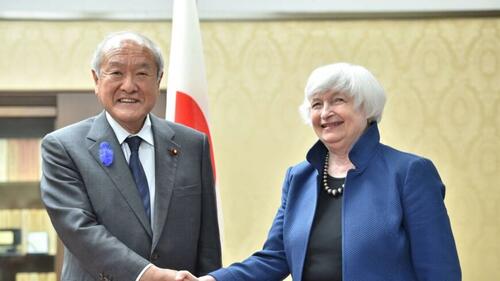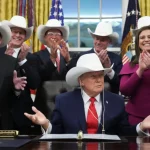
Something strange is going on: while we already know that the BOJ has spent north of $50 billion in reserves to stop the yen from crashing in response to the BOJ's own policy of recklessly and wantonly throwing infinite yen at the JGB market to preserve Yield Curve Control and avoid a crash in long-term Treasuries, one question many have been asking is whether Japan is spending all this money (the BOJ is effectively doing the Fed's job for it, injecting billions in USD into the market which is painfully short the greenback) without any coordination with the US. If so, it would be effectively one central bank doing what everyone in the market is advised to never do: fight the Fed.
Someone forgot to tell the BOJ not to fight the Fed. They'll learn
— zerohedge (@zerohedge) October 24, 2022
So what's the deal? Well, it turns out there is even more confusion here, because depending on who one listens to there either is coordination... or there isn't.
Let's start with Japan, whose Finance Minister Shunichi Suzuki who first said on Tuesday there was no policy contradiction between his ministry's yen-buying to support the currency and the Bank of Japan (BOJ) printing money to sustain its ultra-loose monetary policy.
"Monetary easing aimed at sustainable and stable price hikes including wage growth, and currency intervention in response to excessive market moves, are different in terms of policy objectives, and thus they are not contradictory," Suzuki said.
Actually, there is total contradiction: one policy - Yield Curve Control - is meant to make the yen weaker, the other - FX intervention - is meant to stabilize it. Both eventually offset each other, even as the yen continues to slide due to gargantuan, record yield differentials between the two countries.
So far so good: what is more remarkable is what he said next, namely that Japanese authorities are in constant touch with U.S. counterparts and stand ready to take appropriate action in the currency market against volatile yen moves, according to Reuters.
There's one problem with this take: the US Treasury has no idea what he is talking about.

Quoted by Bloomberg, Treasury Secretary Janet Yellen on Monday declined to comment on reports that the Japanese government is again intervening in currency markets, saying the US government hadn’t received any notice from Tokyo about such a move.
"I’m not aware of any intervention that the Japanese have done, that they’ve indicated they’ve done," Yellen told reporters following a speech in New York.
Yellen was answering questions in response to what was Japan biggest ever currency intervention to prop up the yen which took place late on Friday, and which according to some may have been as large as $37 billion based on Bank of Japan balance of payment figures and an estimate of flows by money broker Central Tanshi Co. That followed an announced move by Japan to intervene in September to buy the yen for the first time since 1998. Market participants also cited probable action from Japan on Monday.
Also of note: Yellen has generally frowned on currency interventions, saying that exchange rates should be market determined, not the result of massive interventions by central banks. After the September intervention, the Treasury issued a statement that fell short of endorsing the move, but saying “we understand Japan’s action.”
So what's going on here? Is Japan simply pretending not to be intervening just to save face the next time the market steamrolls through its intervention bogey - which should be a few days at most - and humiliates the central bank which will have burned through tens of billions of US dollars for nothing? And if so, how many more such interventions will Japan be allowed to do before i) the US realizes that they are counterproductive to its own efforts of fighting inflation, or ii) Tokyo runs out of freely accessible reserves (a number which has been speculated as being around $70 billion after all the recent interventions) and Japan's FinMin is forced to start selling bonds to fund future intervention, a process which however will lead to even sharper dollar appreciation, an even lower yen and is self-defeating from the very beginning.
Something strange is going on: while we already know that the BOJ has spent north of $50 billion in reserves to stop the yen from crashing in response to the BOJ’s own policy of recklessly and wantonly throwing infinite yen at the JGB market to preserve Yield Curve Control and avoid a crash in long-term Treasuries, one question many have been asking is whether Japan is spending all this money (the BOJ is effectively doing the Fed’s job for it, injecting billions in USD into the market which is painfully short the greenback) without any coordination with the US. If so, it would be effectively one central bank doing what everyone in the market is advised to never do: fight the Fed.
Someone forgot to tell the BOJ not to fight the Fed. They’ll learn
— zerohedge (@zerohedge) October 24, 2022
So what’s the deal? Well, it turns out there is even more confusion here, because depending on who one listens to there either is coordination… or there isn’t.
Let’s start with Japan, whose Finance Minister Shunichi Suzuki who first said on Tuesday there was no policy contradiction between his ministry’s yen-buying to support the currency and the Bank of Japan (BOJ) printing money to sustain its ultra-loose monetary policy.
“Monetary easing aimed at sustainable and stable price hikes including wage growth, and currency intervention in response to excessive market moves, are different in terms of policy objectives, and thus they are not contradictory,” Suzuki said.
Actually, there is total contradiction: one policy – Yield Curve Control – is meant to make the yen weaker, the other – FX intervention – is meant to stabilize it. Both eventually offset each other, even as the yen continues to slide due to gargantuan, record yield differentials between the two countries.
So far so good: what is more remarkable is what he said next, namely that Japanese authorities are in constant touch with U.S. counterparts and stand ready to take appropriate action in the currency market against volatile yen moves, according to Reuters.
There’s one problem with this take: the US Treasury has no idea what he is talking about.

Quoted by Bloomberg, Treasury Secretary Janet Yellen on Monday declined to comment on reports that the Japanese government is again intervening in currency markets, saying the US government hadn’t received any notice from Tokyo about such a move.
“I’m not aware of any intervention that the Japanese have done, that they’ve indicated they’ve done,” Yellen told reporters following a speech in New York.
Yellen was answering questions in response to what was Japan biggest ever currency intervention to prop up the yen which took place late on Friday, and which according to some may have been as large as $37 billion based on Bank of Japan balance of payment figures and an estimate of flows by money broker Central Tanshi Co. That followed an announced move by Japan to intervene in September to buy the yen for the first time since 1998. Market participants also cited probable action from Japan on Monday.
Also of note: Yellen has generally frowned on currency interventions, saying that exchange rates should be market determined, not the result of massive interventions by central banks. After the September intervention, the Treasury issued a statement that fell short of endorsing the move, but saying “we understand Japan’s action.”
So what’s going on here? Is Japan simply pretending not to be intervening just to save face the next time the market steamrolls through its intervention bogey – which should be a few days at most – and humiliates the central bank which will have burned through tens of billions of US dollars for nothing? And if so, how many more such interventions will Japan be allowed to do before i) the US realizes that they are counterproductive to its own efforts of fighting inflation, or ii) Tokyo runs out of freely accessible reserves (a number which has been speculated as being around $70 billion after all the recent interventions) and Japan’s FinMin is forced to start selling bonds to fund future intervention, a process which however will lead to even sharper dollar appreciation, an even lower yen and is self-defeating from the very beginning.





